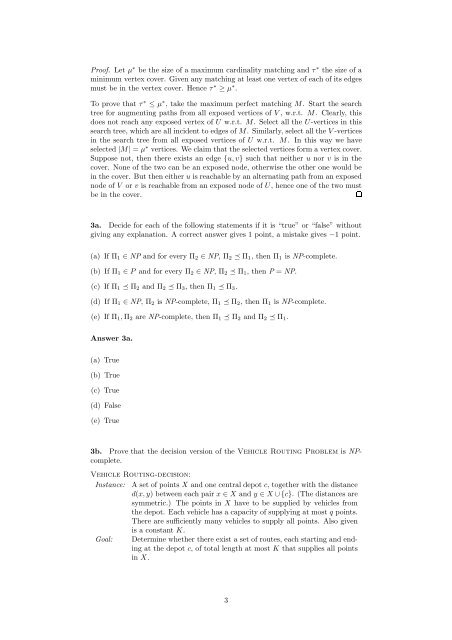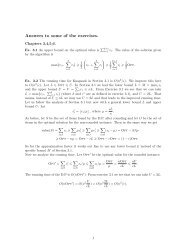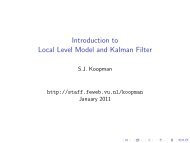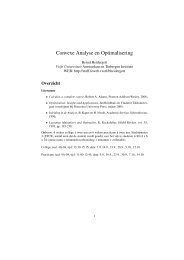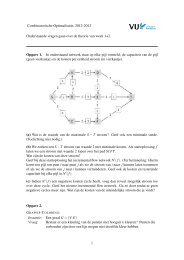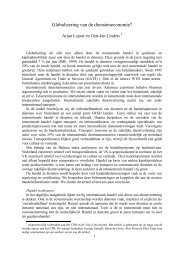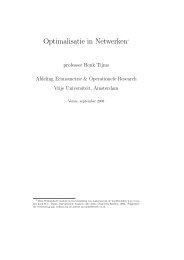You also want an ePaper? Increase the reach of your titles
YUMPU automatically turns print PDFs into web optimized ePapers that Google loves.
Proof. Let µ ∗ be <strong>the</strong> size of a maximum cardinality matching and τ ∗ <strong>the</strong> size of a<br />
minimum vertex cover. Given any matching at least one vertex of each of its edges<br />
must be in <strong>the</strong> vertex cover. Hence τ ∗ ≥ µ ∗ .<br />
To prove that τ ∗ ≤ µ ∗ , take <strong>the</strong> maximum perfect matching M. Start <strong>the</strong> search<br />
tree for augmenting paths from all exposed vertices of V, w.r.t. M. Clearly, this<br />
does not reach any exposed vertex of U w.r.t. M. Select all <strong>the</strong> U-vertices in this<br />
search tree, which are all incident to edges of M. Similarly, select all <strong>the</strong> V-vertices<br />
in <strong>the</strong> search tree from all exposed vertices of U w.r.t. M. In this way we have<br />
selected |M| = µ ∗ vertices. We claim that <strong>the</strong> selected vertices form a vertex cover.<br />
Suppose not, <strong>the</strong>n <strong>the</strong>re exists an edge {u,v} such that nei<strong>the</strong>r u nor v is in <strong>the</strong><br />
cover. None of <strong>the</strong> two can be an exposed node, o<strong>the</strong>rwise <strong>the</strong> o<strong>the</strong>r one would be<br />
in <strong>the</strong> cover. But <strong>the</strong>n ei<strong>the</strong>r u is reachable by an alternating path from an exposed<br />
node of V or v is reachable from an exposed node of U, hence one of <strong>the</strong> two must<br />
be in <strong>the</strong> cover.<br />
3a. Decide for each of <strong>the</strong> following statements if it is “true” or “false” without<br />
giving any explanation. A <strong>correct</strong> answer gives 1 point, a mistake gives −1 point.<br />
(a) If Π1 ∈ NP and for every Π2 ∈ NP, Π2 Π1, <strong>the</strong>n Π1 is NP-complete.<br />
(b) If Π1 ∈ P and for every Π2 ∈ NP, Π2 Π1, <strong>the</strong>n P = NP.<br />
(c) If Π1 Π2 and Π2 Π3, <strong>the</strong>n Π1 Π3.<br />
(d) If Π1 ∈ NP, Π2 is NP-complete, Π1 Π2, <strong>the</strong>n Π1 is NP-complete.<br />
(e) If Π1,Π2 are NP-complete, <strong>the</strong>n Π1 Π2 and Π2 Π1.<br />
Answer 3a.<br />
(a) True<br />
(b) True<br />
(c) True<br />
(d) False<br />
(e) True<br />
3b. Prove that <strong>the</strong> decision <strong>version</strong> of <strong>the</strong> Vehicle Routing Problem is NPcomplete.<br />
Vehicle Routing-decision:<br />
Instance: A set of points X and one central depot c, toge<strong>the</strong>r with <strong>the</strong> distance<br />
d(x,y) between each pair x ∈ X and y ∈ X∪{c}. (The distances are<br />
symmetric.) The points in X have to be supplied by vehicles from<br />
<strong>the</strong> depot. Each vehicle has a capacity of supplying at most q points.<br />
There are sufficiently many vehicles to supply all points. Also given<br />
is a constant K.<br />
Goal: Determine whe<strong>the</strong>r <strong>the</strong>re exist a set of routes, each starting and ending<br />
at <strong>the</strong> depot c, of total length at most K that supplies all points<br />
in X.<br />
3


